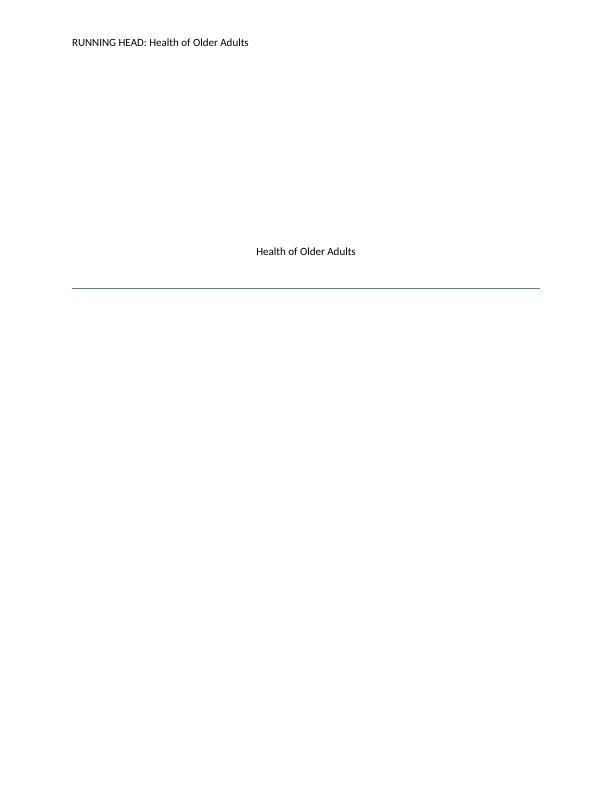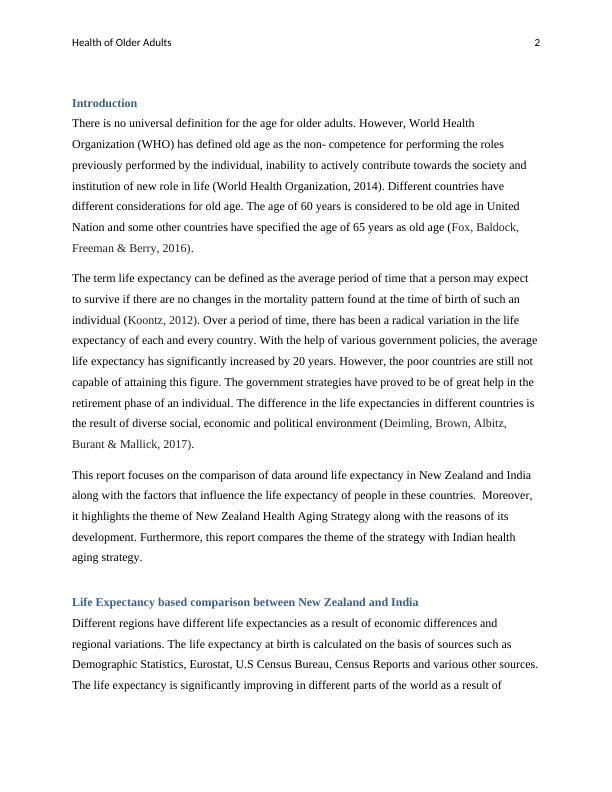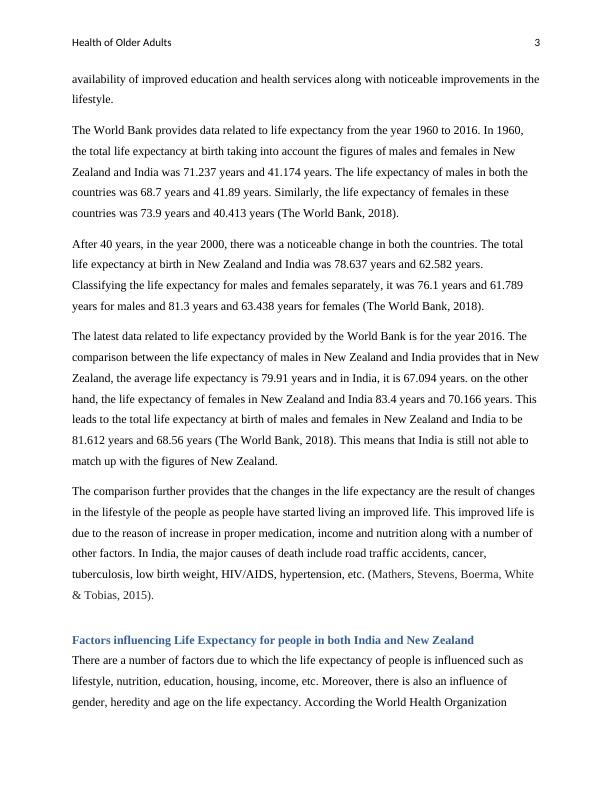Health of Older Adults: A Comparison of Life Expectancy and Strategies in New Zealand and India
Added on 2023-06-11
11 Pages3670 Words192 Views
RUNNING HEAD: Health of Older Adults
Health of Older Adults
Health of Older Adults

Health of Older Adults 1
Contents
Introduction......................................................................................................................................2
Life Expectancy based comparison between New Zealand and India.............................................2
Factors influencing Life Expectancy for people in both India and New Zealand...........................3
New Zealand Healthy Aging Strategy.............................................................................................5
Analysis of the Background of the Strategy along with the reason behind its development..........5
Comparison of the theme of New Zealand Healthy Aging Strategy with Indian Healthy Aging
Strategy............................................................................................................................................6
Conclusion.......................................................................................................................................7
References........................................................................................................................................9
Contents
Introduction......................................................................................................................................2
Life Expectancy based comparison between New Zealand and India.............................................2
Factors influencing Life Expectancy for people in both India and New Zealand...........................3
New Zealand Healthy Aging Strategy.............................................................................................5
Analysis of the Background of the Strategy along with the reason behind its development..........5
Comparison of the theme of New Zealand Healthy Aging Strategy with Indian Healthy Aging
Strategy............................................................................................................................................6
Conclusion.......................................................................................................................................7
References........................................................................................................................................9

Health of Older Adults 2
Introduction
There is no universal definition for the age for older adults. However, World Health
Organization (WHO) has defined old age as the non- competence for performing the roles
previously performed by the individual, inability to actively contribute towards the society and
institution of new role in life (World Health Organization, 2014). Different countries have
different considerations for old age. The age of 60 years is considered to be old age in United
Nation and some other countries have specified the age of 65 years as old age (Fox, Baldock,
Freeman & Berry, 2016).
The term life expectancy can be defined as the average period of time that a person may expect
to survive if there are no changes in the mortality pattern found at the time of birth of such an
individual (Koontz, 2012). Over a period of time, there has been a radical variation in the life
expectancy of each and every country. With the help of various government policies, the average
life expectancy has significantly increased by 20 years. However, the poor countries are still not
capable of attaining this figure. The government strategies have proved to be of great help in the
retirement phase of an individual. The difference in the life expectancies in different countries is
the result of diverse social, economic and political environment (Deimling, Brown, Albitz,
Burant & Mallick, 2017).
This report focuses on the comparison of data around life expectancy in New Zealand and India
along with the factors that influence the life expectancy of people in these countries. Moreover,
it highlights the theme of New Zealand Health Aging Strategy along with the reasons of its
development. Furthermore, this report compares the theme of the strategy with Indian health
aging strategy.
Life Expectancy based comparison between New Zealand and India
Different regions have different life expectancies as a result of economic differences and
regional variations. The life expectancy at birth is calculated on the basis of sources such as
Demographic Statistics, Eurostat, U.S Census Bureau, Census Reports and various other sources.
The life expectancy is significantly improving in different parts of the world as a result of
Introduction
There is no universal definition for the age for older adults. However, World Health
Organization (WHO) has defined old age as the non- competence for performing the roles
previously performed by the individual, inability to actively contribute towards the society and
institution of new role in life (World Health Organization, 2014). Different countries have
different considerations for old age. The age of 60 years is considered to be old age in United
Nation and some other countries have specified the age of 65 years as old age (Fox, Baldock,
Freeman & Berry, 2016).
The term life expectancy can be defined as the average period of time that a person may expect
to survive if there are no changes in the mortality pattern found at the time of birth of such an
individual (Koontz, 2012). Over a period of time, there has been a radical variation in the life
expectancy of each and every country. With the help of various government policies, the average
life expectancy has significantly increased by 20 years. However, the poor countries are still not
capable of attaining this figure. The government strategies have proved to be of great help in the
retirement phase of an individual. The difference in the life expectancies in different countries is
the result of diverse social, economic and political environment (Deimling, Brown, Albitz,
Burant & Mallick, 2017).
This report focuses on the comparison of data around life expectancy in New Zealand and India
along with the factors that influence the life expectancy of people in these countries. Moreover,
it highlights the theme of New Zealand Health Aging Strategy along with the reasons of its
development. Furthermore, this report compares the theme of the strategy with Indian health
aging strategy.
Life Expectancy based comparison between New Zealand and India
Different regions have different life expectancies as a result of economic differences and
regional variations. The life expectancy at birth is calculated on the basis of sources such as
Demographic Statistics, Eurostat, U.S Census Bureau, Census Reports and various other sources.
The life expectancy is significantly improving in different parts of the world as a result of

Health of Older Adults 3
availability of improved education and health services along with noticeable improvements in the
lifestyle.
The World Bank provides data related to life expectancy from the year 1960 to 2016. In 1960,
the total life expectancy at birth taking into account the figures of males and females in New
Zealand and India was 71.237 years and 41.174 years. The life expectancy of males in both the
countries was 68.7 years and 41.89 years. Similarly, the life expectancy of females in these
countries was 73.9 years and 40.413 years (The World Bank, 2018).
After 40 years, in the year 2000, there was a noticeable change in both the countries. The total
life expectancy at birth in New Zealand and India was 78.637 years and 62.582 years.
Classifying the life expectancy for males and females separately, it was 76.1 years and 61.789
years for males and 81.3 years and 63.438 years for females (The World Bank, 2018).
The latest data related to life expectancy provided by the World Bank is for the year 2016. The
comparison between the life expectancy of males in New Zealand and India provides that in New
Zealand, the average life expectancy is 79.91 years and in India, it is 67.094 years. on the other
hand, the life expectancy of females in New Zealand and India 83.4 years and 70.166 years. This
leads to the total life expectancy at birth of males and females in New Zealand and India to be
81.612 years and 68.56 years (The World Bank, 2018). This means that India is still not able to
match up with the figures of New Zealand.
The comparison further provides that the changes in the life expectancy are the result of changes
in the lifestyle of the people as people have started living an improved life. This improved life is
due to the reason of increase in proper medication, income and nutrition along with a number of
other factors. In India, the major causes of death include road traffic accidents, cancer,
tuberculosis, low birth weight, HIV/AIDS, hypertension, etc. (Mathers, Stevens, Boerma, White
& Tobias, 2015).
Factors influencing Life Expectancy for people in both India and New Zealand
There are a number of factors due to which the life expectancy of people is influenced such as
lifestyle, nutrition, education, housing, income, etc. Moreover, there is also an influence of
gender, heredity and age on the life expectancy. According the World Health Organization
availability of improved education and health services along with noticeable improvements in the
lifestyle.
The World Bank provides data related to life expectancy from the year 1960 to 2016. In 1960,
the total life expectancy at birth taking into account the figures of males and females in New
Zealand and India was 71.237 years and 41.174 years. The life expectancy of males in both the
countries was 68.7 years and 41.89 years. Similarly, the life expectancy of females in these
countries was 73.9 years and 40.413 years (The World Bank, 2018).
After 40 years, in the year 2000, there was a noticeable change in both the countries. The total
life expectancy at birth in New Zealand and India was 78.637 years and 62.582 years.
Classifying the life expectancy for males and females separately, it was 76.1 years and 61.789
years for males and 81.3 years and 63.438 years for females (The World Bank, 2018).
The latest data related to life expectancy provided by the World Bank is for the year 2016. The
comparison between the life expectancy of males in New Zealand and India provides that in New
Zealand, the average life expectancy is 79.91 years and in India, it is 67.094 years. on the other
hand, the life expectancy of females in New Zealand and India 83.4 years and 70.166 years. This
leads to the total life expectancy at birth of males and females in New Zealand and India to be
81.612 years and 68.56 years (The World Bank, 2018). This means that India is still not able to
match up with the figures of New Zealand.
The comparison further provides that the changes in the life expectancy are the result of changes
in the lifestyle of the people as people have started living an improved life. This improved life is
due to the reason of increase in proper medication, income and nutrition along with a number of
other factors. In India, the major causes of death include road traffic accidents, cancer,
tuberculosis, low birth weight, HIV/AIDS, hypertension, etc. (Mathers, Stevens, Boerma, White
& Tobias, 2015).
Factors influencing Life Expectancy for people in both India and New Zealand
There are a number of factors due to which the life expectancy of people is influenced such as
lifestyle, nutrition, education, housing, income, etc. Moreover, there is also an influence of
gender, heredity and age on the life expectancy. According the World Health Organization

End of preview
Want to access all the pages? Upload your documents or become a member.
Related Documents
Life Expectancy Assignment | International Government Strategieslg...
|11
|3473
|122
Report on Health of Older Adults in New Zealand and Indialg...
|9
|2842
|24
HLTH.7105 Healthy Ageing Strategylg...
|15
|3872
|256
Adult Health Care Assignmentlg...
|14
|3000
|114
Health And Health Care For Older Adults PDFlg...
|14
|3615
|73
Health of Older Adultlg...
|12
|3496
|375
